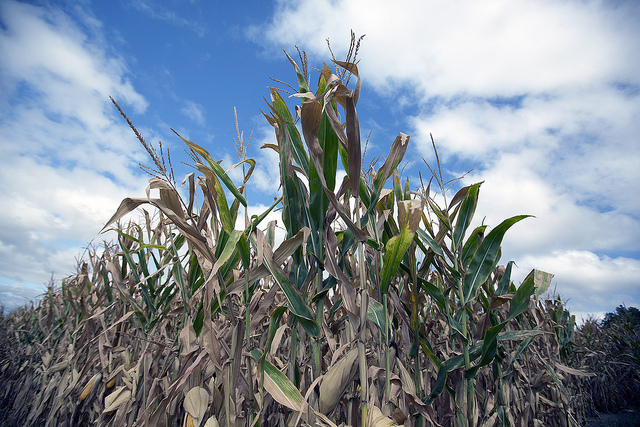Podcast: Play in new window | Download
Subscribe: RSS

Drought-stricken corn under a hot and rainless Iowa sky last week. Two more studies say, things are going to get worse. (Photo by USDA)
The train is coming at 80 miles per hour. Children are playing on the railroad tracks, oblivious. The train is closer now. The children are not aware of it. You can hear the train, people are yelling at you that it is coming, and you, my friend, stand there near the children, not moving, thinking of other things. Thus climate change bears down on us, thus peak oil comes closer at 80 miles per hour, and thus does our water run out. Two shouted warnings about water just this week.
Warning One from a research team based in Canada and the Netherlands, compared water use around the world with underground water resources (underground is where 99 per cent of the world’s fresh melted water is located).
It is striking, by the way, how badly the Reuters news service mis-characterized the study in their lede: “The world is depleting underground water reserves faster than they can be replenished due to overexploitation.” In fact, as a later sentence in the Reuters story more accurately reports, the study found that 80 percent of the world’s aquifers are being used sustainably.
That’s the good news, along with the observation that North Africa has tremendous aquifers available to help them deal with desertification. The bad news is that certain areas of the world are in fact rapidly depleting their reserves of water. We might assume that these would be in some of the world’s most backward places. They are in fact western Mexico, Iran, northern India, Saudi Arabia, parts of northern China — and two large sections of the United States, the High Plains and California’s Central Valley.
We might also assume that when these areas run out of water, it will be their problem and not ours. But these are among the world’s most productive agricultural areas — indeed, the practices of industrial agriculture are the reason they are using up their water — and when they go down, people all over the plant will starve.
Warning Two: A new computer model developed by the National Center for Atmospheric Research has increased confidence in predictions that the western and southern United States are in for at least 20 more years of severe droughts.
Again, there was remarkable sloppiness in the Washington Post story on the study. Noting that the model achieved its more reliable results (reliability is tested by inputting data from an earlier time and checking the model’s output with historical data) by referencing sea-surface temperatures in the eastern Pacific Ocean, the story said “the main culprit currently is a cold cycle” there. [Emphasis added]
I have not read the study, but I have read enough of them to be certain that it did not say that the cold sea-surface temperatures “cause” the droughts, rather that they are “associated with” them. Roosters’ calls are associated with morning, they do not cause morning. Still, one is a reliable predictor of the other.
Lacking from both stories — indeed, from just about all stories on the gathering, perfect storm of industrial consequences about to engulf the world, is any sense of what will happen when these studies are borne out. What will the Plains and the Southwest look like after another 20 years of severe droughts? Where will we get our food when the aquifers under California and the High Plains give out?
Two blasts from the horn of the oncoming train. The children are still at play.
SEE ALSO:
La Niňa: In English, it Means Scapegoat
A Town in Texas: This is How it Ends